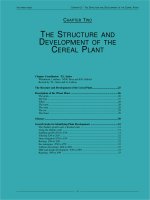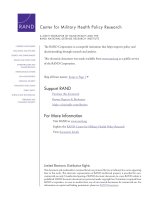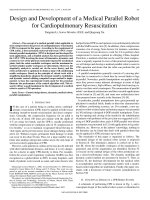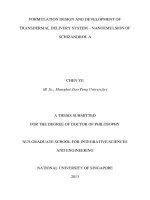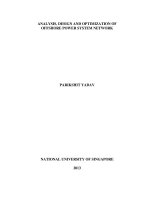Formulation design and development of transdermal delivery system nanoemulsion of schizandrol a
Bạn đang xem bản rút gọn của tài liệu. Xem và tải ngay bản đầy đủ của tài liệu tại đây (9.45 MB, 245 trang )
FORMULATION DESIGN AND DEVELOPMENT OF
TRANSDERMAL DELIVERY SYSTEM – NANOEMULSION OF
SCHIZANDROL A
CHEN YE
(B. Sc., Shanghai Jiao Tong University)
A THESIS SUBMITTED
FOR THE DEGREE OF DOCTOR OF PHILOSOPHY
NUS GRADUATE SCHOOL FOR INTEGRATIVE SCIENCES
AND ENGINEERING
NATIONAL UNIVERSITY OF SINGAPORE
2013
II
DECLARATION
I hereby declare that the thesis is my original work and it has been
written by me in its entirety. I have duly acknowledged all the sources of
information which have been used in the thesis.
This thesis has also not been submitted for any degree in any university
previously.
_________________
Chen Ye
16 August 2013
III
ACKNOWLEDGEMENTS
First of all, I would like to express my earnest gratitude and deepest
thanks to my supervisors Dr. Keith John Carpenter, Professor Reginald Tan
and Dr. Sanggu Kim for their great patience, enormous support and unfailing
encouragement throughout my PhD candidature. I feel so honored to have Dr
Carpenter as my main supervisor who granted me the invaluable opportunity
to study at the Institute of Chemical and Engineering Sciences (ICES). I am
the most grateful to Professor Tan for his constructive comments, fruitful
discussions and professional guidance. I owe my deepest gratitude to Dr. Kim.
This thesis would not have been possible without his tireless efforts, ongoing
support and constant inspirations. I am also grateful to my TAC chairman,
Professor Li Fong Yau, for his reviews, criticisms and advices throughout
each milestone of mine. I could not be more fortunate ever to have this thesis
advisory committee.
I would like to give my special thanks to Mr. Lim Ming Wei, for his
various help throughout the entire course. I appreciate the laboratory officers
in the Crystallisation & Particle Science group of ICES, especially Ms. Tan Li
Teng, Mr. Ng Jun Wei and Mr. Toh Kun Yuan, for their indispensable help
and technical support during my study. I thank Ms. Tan Li Teng for her hard
work and kind help on the SEM. I thank Ms. Angeline Seo for her kind
technical support on the TEM. Furthermore, I wish to express my heartfelt
gratitude to ICES staff, Dr. Dong Yuan Cai, Dr. Ye Li Dan and so many
others, for expert opinions, general discussion and words of encouragement to
me. My sincere thanks go to the past and present postgraduate students in
IV
ICES, especially Dr. Lai Lin Fei, Dr. Gong Dang Guo, and Ms. Poovizhi
Ponnammal Purushothaman, for giving me such a wonderful and memorable
time when studying together with them. I am thankful to all who helped me
weather the storm and raised my spirit during challenging times.
I thank my dearest companion, Ms. Ji Kaili, for going through thick and
thin together during the PhD journey.
There are more I should list their names here, who will always be in my
thankful heart. There are more I should say than a simple “thank you” to all
those who have supported me. Your support is more than priceless to me.
Last but not least, I would like to extend my sincere gratitude to the
National University of Singapore for providing the scholarship and to ICES
for providing various research facilities.
V
I dedicate this thesis to my family.
VI
TABLE OF CONTENTS
DECLARATION II
SUMMARY XI
LIST OF TABLES XIV
LIST OF FIGURES XVI
LIST OF SYMBOLS XX
LIST OF ABBREVIATIONS XXII
CHAPTER 1 INTRODUCTION 1
1.1 Overview 1
1.2 Background and Significance 2
1.3 Objectives and Scope of Study 3
1.4 Organization of the Thesis 5
CHAPTER 2 LITERATURE REVIEW 7
2.1 Cosmeceuticals 7
2.1.1 Emergence of cosmeceuticals 7
2.1.2 Limitations and formulation challenges of cosmeceuticals 11
2.1.3 Schizandrol A as a cosmeceutical ingredient 14
2.1.3.1 Pharmacological activities of schizandrol A 16
2.1.3.2 Bioavailability of schizandrol A 19
2.2 Transdermal Delivery 21
2.2.1 Routes of administration 21
2.2.2 Principles of transdermal delivery 22
2.2.2.1 The structure of human skin 22
VII
2.2.2.2 Routes of penetration through the skin 26
2.2.2.3 State-of-the-art of transdermal delivery systems 27
2.2.3 Advantages and formulation challenges of transdermal delivery
28
2.3 Nanoemulsion as Delivery System 30
2.3.1 Definition and characteristics of nanoemulsion 31
2.3.2 Composition and formation of nanoemulsion 34
2.3.2.1 Components of nanoemulsion 34
2.3.2.2 High energy approaches 36
2.3.2.3 Low energy approaches 39
2.3.3 Advantages and formulation challenges of nanoemulsion 40
2.3.4 Practical application of nanoemulsion 42
CHAPTER 3 METHODOLOGY 44
3.1 Materials 44
3.2 Experimental Design 45
3.3 Method 50
3.3.1 Preformulation characterization 50
3.3.1.1 Elemental analysis 50
3.3.1.2 Phase analysis 50
3.3.1.3 Thermal analysis 51
3.3.2 Phase solubility studies 52
3.3.2.1 Schizandrol A solubility measurement 52
3.3.2.2 Stability of schizandrol A in aqueous solutions 53
VIII
3.3.3 Construction of pseudo-ternary phase diagram 54
3.3.4 Preparation of nanoemulsion 55
3.3.5 Physicochemical characterization of nanoemulsion 56
3.3.5.1 Optical measurement 56
3.3.5.2 Analysis of droplet size and polydispersity index 56
3.3.5.3 Physicochemical properties of nanoemulsion formulation 57
3.3.5.4 Microstructure studies 58
3.3.5.5 Stability studies 59
3.3.6 In vitro permeation test 60
3.3.6.1 Materials and equipment 60
3.3.6.2 Experimental 62
3.3.7 Statistical analysis 62
CHAPTER 4 RESULTS AND DISCUSSION 64
4.1 Preformulation Characterization 64
4.1.1 Elemental analysis 64
4.1.2 Phase analysis 66
4.1.3 Thermal analysis 70
4.2 Phase Solubility Studies 72
4.2.1 Solubility of schizandrol A by micellization 72
4.2.2 Solubility of schizandrol A by cosolvency 79
4.2.3 Solubility of schizandrol A by complexation 86
4.2.4 Solubility of schizandrol A in combination 92
4.2.4.1 Mixed micelles 92
IX
4.2.4.2 Combination of sucrose laurate and cosolvent 96
4.2.4.3 Combination of sucrose laurate and cyclodextrin 98
4.2.5 Solubility of schizandrol A in oils 100
4.2.6 Stability of schizandrol A in aqueous solutions 102
4.2.6.1 Effect of temperature and storage time 102
4.2.6.2 Chemical stability of schizandrol A under UV exposure . 106
4.3 Pseudo-ternary Phase Diagrams 107
4.3.1 Effect of cosurfactants 107
4.3.2 Effect of surfactant to cosurfactant weight (S
m
) ratios 111
4.4 Preparation of Nanoemulsion 117
4.4.1 Impact of process parameters 118
4.4.1.1 Operating homogenizing pressure 118
4.4.1.2 Number of homogenization passes 123
4.4.2 Impact of formulation variables 126
4.4.2.1 Concentration of oil phase 126
4.4.2.2 Concentration of emulsifiers 129
4.4.2.3 Composition of emulsifiers 133
4.5 Characterization of Nanoemulsion Containing Schizandrol A 139
4.5.1 Droplet size and polydispersity index 139
4.5.2 Microstructure study 145
4.5.3 Physicochemical properties of nanoemulsion formulation 149
4.5.4 Stability studies 151
4.6 In Vitro Permeation Studies 160
X
CHAPTER 5 CONCLUSIONS 164
CHAPTER 6 FUTURE WORK 169
BIBLIOGRAPHY 172
APPENDIX I 205
APPENDIX II 209
APPENDIX III 215
XI
SUMMARY
The advent of cosmeceuticals and modern drug discovery techniques has
generated extensive research in botanicals to develop health-promoting
cosmeceutical products. However, most of these botanicals with high
therapeutic potential are poorly water-soluble. Additionally, the skin barrier
poses a biological obstacle to cosmeceutical products. Hence, it is a great
challenge to present and deliver these molecules and achieve adequate
bioavailability. One attractive approach to improve the percutaneous
absorption and bioavailability of cosmeceuticals is to formulate them in a
nanoemulsion delivery system. In this work, an innovative delivery system
(oil-in-water nanoemulsion) capable of penetrating into the deeper skin layers
(transdermal delivery) was developed for a novel cosmeceutical ingredient
(schizandrol A). Clean and green strategies, encompassing minimization of
surfactant amount, use of inexpensive, nontoxic and environment-friendly
solvent, and biodegradable compounds in support of sustainable materials
were implemented.
The intrinsic physicochemical properties of schizandrol A were first
examined to establish the preformulation characterization profile. Next,
components of the nanoemulsion were selected based on solubility and
compatibility studies. Solubilization methods, namely micellization,
cosolvency and complexation, were proposed to improve the aqueous
solubility of schizandrol A. The solubility capacity of these systems was
studied both individually and in combination. Sucrose laurate exhibited the
highest solubilization capacity in this study and was chosen as the main
XII
surfactant in the nanoemulsion formulation. The cosurfactant was selected
based on compatibility with schizandrol A. Ethyl butanoate was found to be
the most effective oil to solubilize schizandrol A and was therefore selected
for subsequent nanoemulsion formation.
Phase behavior was examined to study the potential of using selected
components to develop the nanoemulsion. The effects of cosurfactants and S
m
ratios were investigated. Based on the pseudo-ternary phase diagrams, a
surfactant to cosurfactant weight ratio (S
m
) of 1:1 was selected.
The nanoemulsion was prepared using the high pressure homogenization
method. Impact of the homogenizer operating pressure and number of
homogenization passes, concentration of oil and surfactant, and the type of
cosurfactant were studied respectively. Droplet size and polydispersity index
were used to evaluate the efficiency of the nanoemulsion preparation.
Schizandrol A was subsequently incorporated to the successful nanoemulsion
formulations.
The particle size analysis by dynamic light scattering (DLS) method
demonstrated the droplets of formulated nanoemulsions were in the nano
range, which was further confirmed by the microstructure studies using
electron microscopes. Formulated nanoemulsions containing schizandrol A
were subjected to a variety of stability tests. Schizandrol A loaded
nanoemulsions were stable under the tested conditions up to 30 days. Based on
in vitro permeation studies using a synthetic membrane, schizandrol A loaded
nanoemulsion formulations displayed improved percutaneous absorption than
water-ethanol (1:1, v/v) mixed solvent.
XIII
The present work has important implications in the design of effective
delivery systems for lignans and other hydrophobic active ingredients intended
for topical use.
XIV
LIST OF TABLES
Table 3.1 Factors and levels of the experiments 49
Table 4.1 Powder X-ray diffraction data of distinguished reflection
peaks for schizandrol A. 67
Table 4.2 Properties and solubilization capacity (κ, mg/g) of non-ionic
surfactants for schizandrol A. 75
Table 4.3 Solubilization capacity (σ) of cosolvents for schizandrol A. .
82
Table 4.4 Cosolvents properties (at ambient temperature) and their
capacity (σ) to solubilize schizandrol A. 83
Table 4.5 Physical properties of cyclodextrins (CD) and their
derivatives. 88
Table 4.6 Solubilization capacity (τ) and stability constant (K
1:1
, M
-1
)
of cyclodextrins for schizandrol A. 90
Table 4.7 Slopes of solubilization profiles for schizandrol A by
combined methods. 94
Table 4.8 HLB values of mixed micelles. 95
Table 4.9 Mean droplet size and polydispersity index of emulsions
containing different oil amount after 50 homogenization passes at 150 MPa.
128
Table 4.10 Mean droplet size and polydispersity index of emulsions
containing different emulsifiers (L1695/ethanol, S
m
=1:1) amount after 50
homogenization passes at 150 MPa. 131
Table 4.11 Mean droplet size and polydispersity index of emulsions
containing different cosurfactant (3% [L1695/CoS], S
m
=1:1) after 50
homogenization passes at 150 MPa. 137
Table 4.12 Mean droplet size and polydispersity index of emulsions
containing different surfactant to cosurfactant (3% [L1695/ethanol]) weight
ratio (S
m
) after 50 homogenization passes at 150 MPa. 137
Table 4.13 Experimental design for schizandrol A loaded
nanoemulsions. 139
Table 4.14 Droplet size and PDI value of the developed nanoemulsion
formulations containing schizandrol A. 140
XV
Table 4.15 Physicochemical properties of nanoemulsion formulation
containing schizandrol A. . 150
Table I.1 Solubility capacity of Tween-based system for schizandrol A.
………………………………………………………………208
Table III.1 Number of homogenization passes needed for preparation of
transparent nanoemulsion formulation bases (operating pressure at 150 MPa).
………………………………………………………………216
Table III.2 Physicochemical properties of nanoemulsion formulation bases
(10 wt% ethyl butanoate). ……………………………………… ……… 217
XVI
LIST OF FIGURES
Figure 2.1 Lignan carbon framework. 16
Figure 2.2 Chemical structure of schizandrol A. 16
Figure 2.3 A schematic drawing of human skin structure (Murthy and
Shivakumar, 2010). Three macroroutes for penetration through skin are
labeled: Route 1—via hair follicles with associated sebaceous glands; Route
2—via transepidermal (stratum corneum); Route 3—via sweat ducts. 23
Figure 2.4 A schematic diagram of the “bricks and mortar”
arrangement of human stratum corneum (Elias, 1991; Nemes and Steinert,
1999). 24
Figure 2.5 Schematic representation of high pressure homogenization
method. 38
Figure 3.1 Flowchart of experimental design. 45
Figure 4.1
1
H-NMR resonance signals of schizandrol A in CDCl
3
. The
chemical shift scale is relative to TMS at δ=0. 65
Figure 4.2
13
C-NMR resonance signals of schizandrol A in CDCl
3
. The
chemical shift scale is relative to TMS at δ=0. 65
Figure 4.3 Powder X-Ray diffraction pattern of schizandrol A (CuKα,
35 kV/40 mA). 67
Figure 4.4 FTIR spectrum of schizandrol A in mid-IR region (4500-
400 cm
-1
). 69
Figure 4.5 TGA spectrum of schizandrol A. 70
Figure 4.6 DSC thermogram of schizandrol A. 71
Figure 4.7 Solubilization of schizandrol A by micellization. 75
Figure 4.8 Chemical structures of non-ionic surfactants. (A) sucrose
monolaurate; (B) Tween 20; (C) Tween 40; (D) Tween 80. 76
Figure 4.9 Solubilization of schizandrol A by cosolvency. 81
Figure 4.10 Solubilization of schizandrol A by PEGs. 82
Figure 4.11 Schematic diagram of cyclodextrin inclusion complex
formation (guest/host=1:1) 87
Figure 4.12 Chemical structures of complexants. (A) β-cyclodextrin (β-
CD); (B) γ-cyclodextrin (γ-CD); (C) 2-hydroxypropyl-β-cyclodextrin (HP-β-
CD); (D) 2-hydroxypropyl-γ-cyclodextrin (HP-γ-CD). 88
XVII
Figure 4.13 Solubilization of schizandrol A by cyclodextrins. 90
Figure 4.14 Solubilization of schizandrol A in mixed micelles (1:1)
system. 93
Figure 4.15 Solubilization of schizandrol A in L1695/cosolvent (1:1)
system. 97
Figure 4.16 Solubilization of schizandrol A in L1695/cyclodextrin (1:1)
system. 99
Figure 4.17 Schizandrol A solubility in oil phases. (IPP: isopropyl
palmitate; IPM: isopropyl myristate; CO: castor oil; EO: ethyl oleate; OA:
oleic acid; EnO: ethyl octanoate; EnB: ethyl butanoate). 101
Figure 4.18 Hydrodynamic diameter and polydispersity index (PDI) of
micelle containing schizandrol A in 10% L1695 : PG (1:1) and 10% L1695 :
PEG 400 (1:1) aqueous solutions. 103
Figure 4.19 Concentration of schizandrol A in the aqueous solutions at
different storage temperature: (A) 4 °C, (B) room temperature, (C) 50 °C. 105
Figure 4.20 Concentration of schizandrol A in aqueous solutions under
UV exposure. 106
Figure 4.21 The pseudo-phase diagrams of [L1695/EtOH], [L1695/PG],
[L1695/PEG 400] /ethyl butanoate/water systems at room temperature with
the same weight ratio of surfactant to cosurfactant (S
m
) at 1:1. 109
Figure 4.22 The pseudo-ternary phase diagram of [L1965/EtOH]/Ethyl
butanoate/water system at room temperature with different weight ratio of
surfactant to cosurfactant (S
m
): 1:2, 1:1, 2:1. 112
Figure 4.23 The pseudo-ternary phase diagram of [L1965/PG]/Ethyl
butanoate/water system at room temperature with different weight ratio of
surfactant to cosurfactant (S
m
): 1:2, 1:1, 2:1. 113
Figure 4.24 The pseudo-ternary phase diagram of [L1965/PEG
400]/Ethyl butanoate/water system at room temperature with different weight
ratio of surfactant to cosurfactant (S
m
): 1:2 and 1:1. 114
Figure 4.25 Droplet size and polydispersity index of nanoemulsion
formation by HPH method at different homogenizing pressure; and typical
size distribution (by intensity) after 50 passes: (A) 100 MPa, (B) 150 MPa, (C)
200 MPa. 122
Figure 4.26 Effect of number of homogenization passes on the average
droplet diameter produced in 3% L1695/ethanol (1:1) ethyl butanoate-in-water
emulsions by HPH method at 150 MPa. 124
XVIII
Figure 4.27 Evolution of particle size distribution (PSD) related to
number of homogenization passes. The model emulsion consisted of 3%
[L1695/ethanol (1:1)]/10% ethyl butanoate/87% water. 125
Figure 4.28 Effect of oil concentration on nanoemulsion formation by
HPH at 150 MPa. The resultant samples in vials are placed in the order of
original coarse emulsion, sample after 10, 20, 30, 40 and 50 passes (from left
to right). 129
Figure 4.29 Effect of emulsifier concentration (wt%) on the mean
droplet size and polydispersity index (PDI) of nanoemulsion formation using
HPH method at 150 MPa. The resultant samples in vials are placed in the
order of original coarse emulsion, sample after 10, 20, 30, 40 and 50 passes
(from left to right). 132
Figure 4.30 Effect of cosurfactant type on L1695-based ethyl
butanoate-in-water nanoemulsion formation: (A) ethanol, (B) propylene glycol,
(C) PEG 400. The resultant samples in vials are placed in the order of original
coarse emulsion, sample after 10, 20, 30, 40 and 50 passes (from left to right). .
136
Figure 4.31 Effect of surfactant to cosurfactant weight ratio (S
m
) on the
average droplet size and PDI value. The resultant samples in vials are placed
in the order of original coarse emulsion, sample after 10, 20, 30, 40 and 50
passes (from left to right). 138
Figure 4.32 Preparation of L1695-based ethyl butanoate oil-in-water
nanoemulsion containing 2 mg/ml schizandrol A: (A) NE1, (B) NE2, (C) NE3,
(D) control samples consisting of 2 mg/ml schizandrol A in ultra-pure water.
The resultant samples in vials are placed in the order of original coarse
emulsion, sample after 10, 20, 30, 40 and 50 passes (from left to right). 144
Figure 4.33 Particle size distributions of samples containing 2 mg/ml
schizandrol A after 50 homogenization passes at 150 MPa. 145
Figure 4.34 TEM images of nanoemulsions containing schizandrol A:
(A) NE1, (B) NE2, (C) NE3. The length of scale bar is 20 nm. 147
Figure 4.35 Cryo-FESEM images of nanoemulsions containing
schizandrol A: (A) NE1, (B) NE2, (C), NE3. The length of scale bar is 100 nm.
149
Figure 4.36 Droplet size and polydispersity index as a function of
temperature for the nanoemulsion formulation containing schizandrol A: (A)
NE1, (B) NE2, (C) NE3. 153
Figure 4.37 Droplet size and polydispersity index as a function of
storage time of the nanoemulsion containing schizandrol A: (A) NE1, (B) NE2,
(C) NE3. 155
XIX
Figure 4.38 Coalescence kinetics of schizandrol A loaded nanoemulsions at
room temperature. The 3*ln(D
t
/D
0
) is plotted against storage time (hour). 156
Figure 4.39 Ostwald ripening kinetics of schizandrol A loaded
nanoemulsions at room temperature. The cube of the mean average droplet
size d
H
3
(nm
3
) is plotted against storage time (hour). …………………… 157
Figure 4.40 Concentration of schizandrol A in the nanoemulsion
formulations as a function of storage time: (A) NE1, (B) NE2, (C) NE3. 159
Figure 4.41 In vitro penetration profiles of cumulative permeated
schizandrol A amount per area obtained for 24 hours by the Franz cell
diffusion test using synthetic membrane. 161
Figure I.1 Solubility of schizandrol A in mixed Tween micelles (1:1). .
….………………………………… ………… …… 205
Figure I.2 Solubility of schizandrol A in Tween/ethanol (1:1) system. .206
Figure I.3 Solubility of schizandrol A in mixed Tween/PEG 400 (1:1)
system. ….………………………………………………………… 206
Figure I.4 Solubility of schizandrol A in Tween/HP-β-CD (1:1) system.
………………………………………………………………207
Figure I.5 Solubility of schizandrol A in Tween/HP-γ-CD (1:1) system.
………………………………………………………………207
Figure II.1 Phase behaviors of L1695-based emulsifiers/triacetin/water
system containing different cosurfactant at different S
m
ratios. Cosurfactant
type: (i) ethanol; (ii) propylene glycol; (iii) PEG 400.
…………………… 211
Figure II.2 Phase behaviors of L1695-based emulsifiers/ethyl
octanoate/water system containing different cosurfactant at different S
m
ratios.
Cosurfactant type: (i) ethanol; (ii) propylene glycol; (iii) PEG 400 ……….213
Figure II.3 Phase behaviors of L1695-based emulsifiers/oleic acid/water
system containing different cosurfactant at different S
m
ratios. Cosurfactant
type: (i) ethanol; (ii) propylene glycol; (iii) PEG 400 …………………… 214
Figure III.1 TEM micrographs of nanoemulsion bases for: (i) A2, (ii) B2,
(iii) C2 containing 10 wt% ethyl butanoate prepared by HPH method (150
MPa, 50 passes). The length of scale bar is 20 nm for (i) and iii, 50 nm for
(ii). ……………………………………………………………………….…219
XX
LIST OF SYMBOLS
∆H
F
enthalpy at fusion
∆S
F
entropy at fusion
C
a
concentration of active ingredient in the aqueous phase
C
CD
concentration of cyclodextrin
C
M
micelle concentration
C
surf
surfactant concentration
C
t
total concentration of active ingredient in the formulation
d
interplanar spacing
D
translational diffusion coefficient
D
0
initial droplet size in the formulation
d
H
hydrodynamic diameter
D
t
droplet size of the formulation at time (t)
H
0
spontaneous curvature
I
intensity
I
0
intensity of the incident beam
K
stability constant of cyclodextrin
k
B
Boltzmann constant
k
c
rate of droplets coalescence
n
refractive index
N
0
numbers of droplets per unit volume of emulsion initially
N
t
numbers of droplets per unit volume of emulsion at time (t)
P
probability of obtaining a test statistic
R
2
coefficient of determination
XXI
R
o
weight ratio of oil phase to emulsifiers
S
0
intrinsic solubility
S
m
surfactant-to-cosurfactant weight ratio
S
tot
total solubility
T
absolute temperature
T
transmittance
T
F
temperature of fusion
T
in
initial temperature
γ
interfacial tension
δ
chemical shift
δ
solubility parameter
ε
dielectric constant
η
dynamic viscosity
θ
angle of incidence or diffraction
κ
solubilization capacity of surfactant
λ
wavelength
ν
0
Larmor frequency
ρ
membrane porosity
σ
electrical conductivity
σ
solubilization capacity of cosolvent
τ
membrane tortuosity
τ
solubilization capacity of cyclodextrin
Φ
number of phases
XXII
LIST OF ABBREVIATIONS
ANOVA
Analysis of Variance
API
Active Pharmaceutical Ingredient
BPC
Bulk Pharmaceutical Chemical
CAS
Chemical Abstract Service
CC
50
Cytotoxic Concentration 50
CCD
Charge coupled device
CCl
4
Carbon tetrachloride
CD
Cyclodextrin
CMC
Critical Micelle Concentration
CO
Castor Oil
conc.
Concentration
CoS
Cosurfactant
COX-2
Cyclooxygenase-2
CYP
Cytochrome P450
DLS
Dynamic Light Scattering
DSC
Differential Scanning Calorimetry
EC
50
Effective Concentration 50
EnB
Ethyl-n-butanoate
EnO
Ethyl-n-octanoate
EO
Ethyl oleate
ER
Estrogen Receptor
ET
50
Effective Time to reduce tissue viability by 50%
EtOH
Ethanol
XXIII
FD&C Act
Federal Food, Drug, and Cosmetic Act
FDA
Food and Drug Administration
FESEM
Field Emission Scanning Electron Microscopy
FTIR
Fourier Transform Infrared Spectroscopy
GI
Gastrointestinal
GL
Glycerin
Glu
Glutamate
GOT
Glutamic-oxaloacetic Transaminase
GPT
Glutamic-pyruvic Transaminase
GRAS
Generally Regarded As Safe
HCl
Hydrogen chloride
HEKs
Human Epidermal Keratinocytes
HIV
Human Immunodeficiency Virus
HLB
Hydrophilic-Lipophilic Balance
HPH
High Pressure Homogenization
HPLC
High Performance Liquid Chromatography
HP-β-CD
2-hydroxypropyl-β-cyclodextrin
HP-γ-CD
2-hydroxypropyl-γ-cyclodextrin
IC
50
Inhibitory Concentration 50
ICH Q7A
International Conference on Harmonisation of Technical
Requirements for Registration of Pharmaceuticals for Human
Use; Q7A: Good Manufacturing Practice Guidance for Active
Pharmaceutical Ingredients
IgE
Immunoglobulin E
IM
Intramuscular
XXIV
iNOS
Inducible Nitric Oxide Synthase
IPM
Isopropyl myristate
IPP
Isopropyl palmitate
IV
Intravenous
JNK
c-Jun N-terminal Kinase
KBr
Potassium bromide
KCl
Potassium chloride
KH
2
PO
4
Monopotassium phosphate
kPa
Kilopascals
kV
Kilovolt
LC
50
Lethal Concentration 50
logP
Octanol-water partition coefficient
MAPK
Mitogen-activated Protein Kinases
ME
Microemulsion
MW
Molecular weight
MPa
Megapascal
MTT
3-(4,5-dimethylthiazol-2-yl)-2,5-diphenyltetrazolium bromide
N/A
Not applicable
NaCl
Sodium chloride
NaH
2
PO
2
∙H
2
O
Sodium hypophosphite monohydrate
NE
Nanoemulsion
NF-κB
Nuclear Factor kappa B
NIBS
Non-Invasive Back-Scatter
NMR
Nuclear Magnetic Resonance
NO
Nitric oxide
XXV
o/w
oil in water
OA
Oleic acid
OTC
Over-The-Counter
OVA
Ovalbumin
p.o.
per os
PBS
Phosphate Buffered Saline
PCS
Photon Correlation Spectroscopy
PDI
Polydispersity Index
PEG
Poly(ethylene glycol)
PG
Propylene glycol
PGE2
Prostaglandin E2
PHT
Phenytoin
PIT
Phase Inversion Temperature
PMA
Phorbol myristate acetate
PMN
Polymorphonuclear leukocytes
POE
Polyoxyethylene
ppm
parts per million
PSD
Particle Size Distribution
psi
pound force per square inch
PTA
Phosphotungstic acid
PXRD
Powder X-ray Diffraction
S
Surfactant
S.D.
Standard Deviation
SC
Subcutaneous
SEM
Scanning Electron Microscopy

